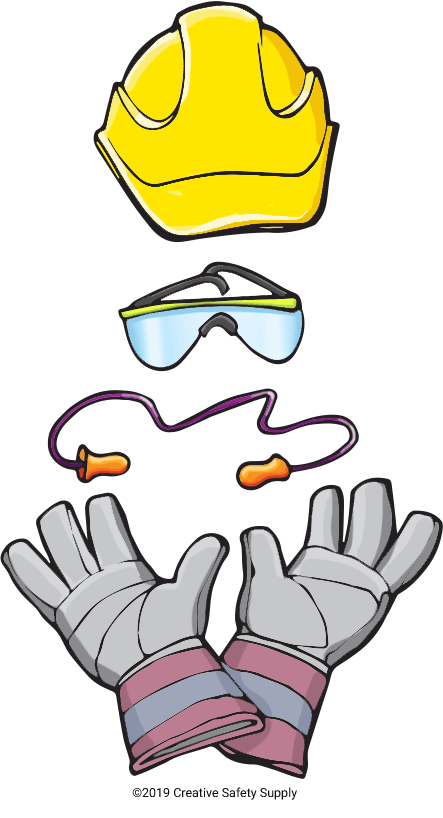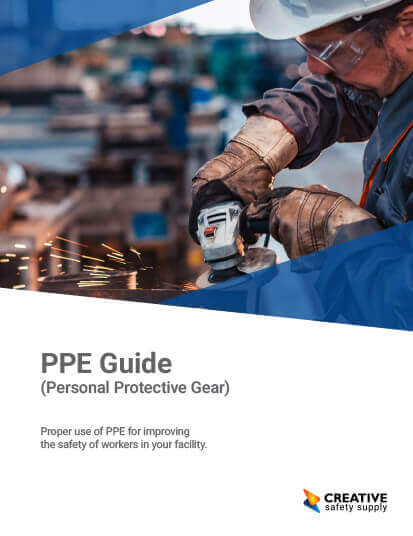
 PPE stands for personal protective equipment, which is any clothing, helmet, goggles, or other gear that is designed to protect the wearer from injury or infection. PPE is used in various settings, such as health care, construction, manufacturing, mining, and sports, to reduce the risk of exposure to hazards that can cause serious harm to the body. PPE can also help prevent the spread of infectious diseases, such as COVID-19, by creating a barrier between the wearer and the source of infection.
PPE stands for personal protective equipment, which is any clothing, helmet, goggles, or other gear that is designed to protect the wearer from injury or infection. PPE is used in various settings, such as health care, construction, manufacturing, mining, and sports, to reduce the risk of exposure to hazards that can cause serious harm to the body. PPE can also help prevent the spread of infectious diseases, such as COVID-19, by creating a barrier between the wearer and the source of infection.
The Importance of PPE
PPE is important because it can help save lives and prevent unnecessary injuries and illnesses in the workplace and beyond. According to the Occupational Safety and Health Administration (OSHA), PPE is "the minimum infection prevention practices that apply to all patient care, regardless of suspected or confirmed infection status of the patient, in any setting where health care is delivered." PPE is also essential for workers who are exposed to chemical, physical, electrical, mechanical, or other hazards that can damage their eyes, ears, head, hands, feet, or respiratory system. PPE can also protect the environment from contamination by hazardous substances.
Some of the benefits of using PPE are:
- It can prevent or reduce the severity of injuries and illnesses, such as cuts, burns, fractures, infections, and cancers.
- It can protect workers from excessive chemical exposure, which can cause acute or chronic health effects, such as irritation, inflammation, poisoning, or cancer.
- It can prevent the spread of germs and infectious diseases, such as COVID-19, by blocking the transmission of droplets, aerosols, or bodily fluids that may contain pathogens.
- It can help businesses comply with regulatory requirements, such as OSHA standards, that aim to ensure the safety and health of workers and customers.
- It can improve employee productivity and efficiency, by reducing absenteeism, turnover, and compensation costs, and by enhancing morale and performance.
The Types of PPE and Their Examples
There are many types of PPE available, depending on the nature and level of the hazard, the work conditions, and the personal preferences of the wearer. Some of the common types of PPE and their examples are:
- Eye and face protection: This includes safety glasses, goggles, face shields, and masks that are used to protect the eyes and face from flying objects, splashes, dust, radiation, or infectious agents. Eye and face protection should be compatible with the prescription glasses or contact lenses of the wearer, and should fit snugly and comfortably.
- Head protection: This includes hard hats, helmets, and caps that are used to protect the head from impact, penetration, or electrical shock. Head protection should be durable, lightweight, and adjustable, and should not interfere with the vision or hearing of the wearer.
- Hearing protection: This includes earplugs, earmuffs, and headphones that are used to protect the ears from loud noises that can cause hearing loss or tinnitus. Hearing protection should be selected based on the noise level, frequency, and duration of exposure, and should fit properly and comfortably.
- Respiratory protection: This includes respirators, masks, and filters that are used to protect the respiratory system from inhaling harmful substances, such as dust, fumes, gases, vapors, or pathogens. Respiratory protection should be selected based on the type and concentration of the contaminant, and should fit tightly and securely.
- Hand and arm protection: This includes gloves, mittens, sleeves, and wristlets that are used to protect the hands and arms from cuts, burns, abrasions, punctures, chemicals, or biological agents. Hand and arm protection should be selected based on the type and degree of the hazard, and should fit properly and comfortably.
- Foot and leg protection: This includes shoes, boots, socks, leggings, and gaiters that are used to protect the feet and legs from falling, rolling, or sharp objects, wet, slippery, or hot surfaces, or electrical hazards. Foot and leg protection should be selected based on the type and degree of the hazard, and should fit properly and comfortably.
- Body protection: This includes clothing, aprons, vests, jackets, coveralls, and suits that are used to protect the body from heat, cold, fire, chemicals, or biological agents. Body protection should be selected based on the type and degree of the hazard, and should be comfortable and allow freedom of movement.
The History of PPE
The history of PPE dates back to ancient times, when soldiers wore protective headgear, face gear, and body armor to fight their enemies without being killed themselves. Some of the earliest forms of PPE were made of leather, metal, or animal skins, and were often heavy and cumbersome. In nonmilitary settings, people have used PPE from at least as far back as the Middle Ages, when blacksmiths wore protective hand gear and aprons or shields to prevent being burned by the molten metal they were working with.
The modern era of PPE began in the 20th century, with the development of new materials, technologies, and standards that improved the design, performance, and availability of PPE. Some of the milestones in the history of PPE are:
- In 1914, Garrett Morgan invented the safety hood, a precursor to the gas mask, that was used by firefighters and miners to protect themselves from smoke and toxic gases.
- In 1919, the Bureau of Mines established the first respirator certification program in the United States, which later became the basis for the National Institute for Occupational Safety and Health (NIOSH) respirator approval program.
- In 1926, Edwin Land invented the polarized lens, which was used to make sunglasses and goggles that reduced glare and eye strain.
- In 1938, DuPont introduced nylon, a synthetic fiber that was used to make gloves, clothing, and parachutes that were strong, lightweight, and resistant to abrasion and chemicals.
- In 1943, the U.S. Army developed the M1 helmet, a steel helmet that provided better protection and comfort than the previous models.
- In 1959, Nils Bohlin invented the three-point seat belt, which reduced the risk of injury and death in car accidents.
- In 1967, the American National Standards Institute (ANSI) published the first standard for eye and face protection, ANSI Z87.1, which established the criteria for testing, marking, and selecting PPE for the eyes and face.
- In 1970, the Occupational Safety and Health Act was passed, which created OSHA and NIOSH, and mandated the provision and use of PPE in the workplace.
- In 1983, Kevlar, a synthetic fiber that was five times stronger than steel, was used to make bulletproof vests and helmets for law enforcement and military personnel.
- In 1987, the first disposable N95 respirator was developed by 3M, which offered a higher level of protection against airborne particles than the previous models.
- In 1992, the Personal Protective Equipment at Work Regulations was enacted in the United Kingdom, which required employers to provide suitable PPE to their employees and ensure its proper use.
- In 2002, the European Union adopted the Directive 89/686/EEC on personal protective equipment, which harmonized the requirements and standards for PPE in the European market.
- In 2020, the COVID-19 pandemic increased the demand and awareness of PPE, especially masks, respirators, gloves, and gowns, to prevent the transmission of the novel coronavirus.
The Future of PPE
The future of PPE is likely to be influenced by the advances in science, technology, and innovation that will enable the development of new materials, designs, and features that will enhance the protection, comfort, and usability of PPE. Some of the trends and challenges that may shape the future of PPE are:
- The integration of smart technologies, such as sensors, cameras, GPS, and wireless communication, that will allow PPE to monitor the wearer’s vital signs, environmental conditions, and location, and provide real-time feedback, alerts, and assistance.
- The adoption of nanotechnology, biotechnology, and biomimicry, that will allow PPE to mimic the properties and functions of natural materials and systems, such as self-cleaning, self-healing, and self-adapting, and provide enhanced protection against emerging hazards, such as nanoparticles, bioterrorism, and radiation.
- The customization and personalization of PPE, that will allow PPE to fit the individual needs and preferences of the wearer, such as size, shape, color, and style, and provide a better fit, comfort, and performance.
- The sustainability and circularity of PPE, that will require PPE to be designed, manufactured, and disposed of in a way that minimizes the environmental impact and maximizes the resource efficiency and value of PPE, such as using renewable, biodegradable, or recycled materials, and implementing reuse, repair, or recycling schemes.
At the end of the day, PPE is an acronym that stands for personal protective equipment, which is any gear that is worn to protect the wearer from injury or infection. PPE is important because it can help save lives and prevent unnecessary injuries and illnesses in various settings, such as health care, construction, manufacturing, mining, and sports. PPE can also help prevent the spread of infectious diseases, such as COVID-19, by creating a barrier between the wearer and the source of infection. PPE can be classified into different types, such as eye and face protection, head protection, hearing protection, respiratory protection, hand and arm protection, foot and leg protection, and body protection, depending on the type and level of the hazard, the work conditions, and the personal preferences of the wearer.
Additional PPE facts:
- The global personal protective equipment (PPE) market size was valued at USD 80.38 billion in 2022 and is projected to grow from USD 77.88 billion in 2023 to USD 121.51 billion by 2031, exhibiting a CAGR of 4.7% during the forecast period. Source: https://www.fortunebusinessinsights.com/personal-protective-equipment-ppe-market-102015
- In August 2021, just over three-fifths (60.5%) of businesses reported that they needed or expected to need PPE to operate in accordance with COVID-19-related public health guidelines, unchanged from May. Businesses in educational services (91.7%) and in accommodation and food services (87.0%) had the highest demand for PPE. Source: https://www150.statcan.gc.ca/n1/daily-quotidien/211018/dq211018b-eng.htm
- OSHA’s general personal protective equipment requirements mandate that employers conduct a hazard assessment of their workplaces to determine what hazards are present that require the use of protective equipment, provide workers with appropriate protective equipment, and require them to use and maintain it in sanitary and reliable condition. Source: https://www.osha.gov/sites/default/files/publications/ppe-factsheet.pdf
- OSHA also provides data on establishments, investigations, frequently cited standards, penalties, and more related to PPE and other safety and health topics. Source: https://www.osha.gov/data
- PPE has a long history of use, dating back to the first century, when workers used dust and respiratory protection. Over the years, PPE has evolved and improved to meet the changing needs and challenges of different industries and occupations. Source: https://www.stericycle.com/en-us/about-us/our-stories/6-things-you-might-not-know-about-ppe
